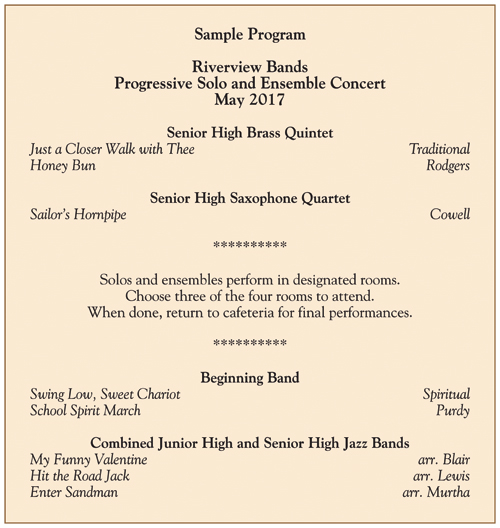Walking the plank, being thrown to the wolves, and performing at a solo and ensemble competition can all be equally terrifying, particularly the first time. No matter how much you try to prepare students, you cannot get them completely ready for the fateful steps they take as they enter the tryout room to face whom they perceive as their judge and musical executioner. On top of that, with the possible exception of an accompanist, they do it alone; students work for weeks to perform their piece for one person and one person only.
A solo and ensemble competition also has an element of mystery in that hardly anyone outside of band knows what it is. I had a principal years ago who called it solo and ensembo; I didn’t have the heart to correct him. Parents often share in this confusion. Few parents know what comprises a brass quintet, and some may even think a brass sextet should be banned from schools.
However, a progressive concert gives students multiple chances to perform their solo and ensemble pieces and increases parent understanding of what students are working on. The basic idea is not original with me; I once read a brief reference to it in a now-forgotten article and created the details based on a progressive dinner I had one Christmas. The audience is treated to multiple courses of music in different locations around the school. Although it is possible to have only solos and ensembles perform, we combine this concert with some full band performances. Every student should be involved, even if it is only in a large ensemble. We keep the dress for this event relatively informal, although if contests are approaching, formal dress may be a better choice.
First Performances
We open the evening with everyone gathered in one place, in our case a cafeteria because we have no auditorium. The program typically opens by featuring one or two of our advanced ensembles, usually a brass quintet and a saxophone ensemble.
Then it is time for the students to go to their respective rooms to prepare for their audience. While they are gone, our band booster organization makes important announcements and has sign-ups for various committees that we will need for the upcoming school year. Once the meeting is completed and the rooms are ready to go, we release the audience members. Because this event will be new to many parents, we have directions printed on a program and posted in the hallways; student guides are stationed in the hallways to help.
Solos and Ensembles
The number of performance rooms depends on the number of solos and ensembles. We typically run four rooms at 30-minute intervals and ask that the parents select three of the four rooms.
The room scheduling can be tricky. Don’t assign more than two events to any student to help reduce room conflicts. Provide a variety of music so each room has a contrast of offerings.
Each room has two people on staff: a reliable student or parent volunteer as the room chairman and a student who can run sound for soloists who do not have an accompanist available that night. If you have enough directors or mature, eloquent high school students, have them give brief explanations on the musical benefits of solo and ensemble playing. If students are going to a competition later, discuss how they will be judged at the event. An area band director moves from room to room, judging the events. At the end of the night, we give awards for what we call the Top Ten Performances, but awards are optional.
The first time we held this event, some parents only watched their child and never visited the other rooms. Since then we have emphasized the importance of parents watching other students besides their own perform, and that has taken care of the problem. Every thirty minutes the audience rotates, and the performers in the room perform again for a new audience.
Final Performances
The program closes back at the original meeting place. It is important to have a final event that requires everyone’s attendance. We use the time to give awards for the outstanding performances and have one or two large ensembles perform. If space allows, have multiple groups set up at the same time so there are no set changes.
The total length of the program is about two hours, but the movement from room to room and the variety of offerings makes it seem much shorter. Regardless of length, it certainly beats walking the plank or being thrown to wolves.







